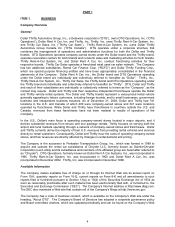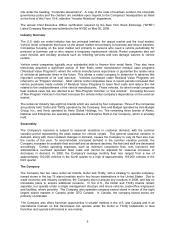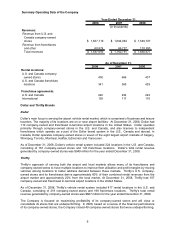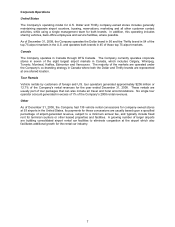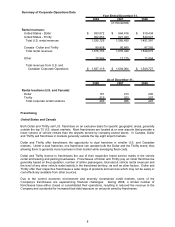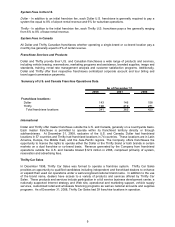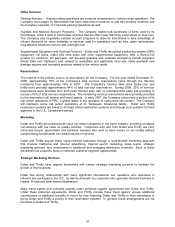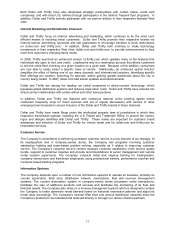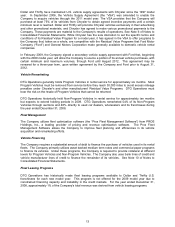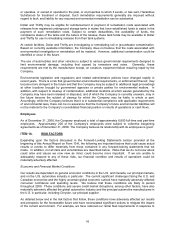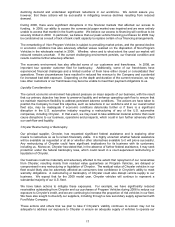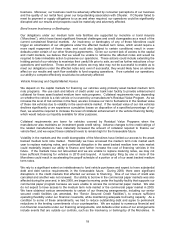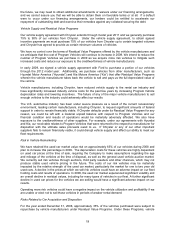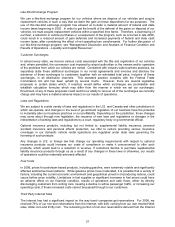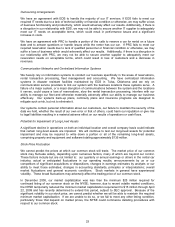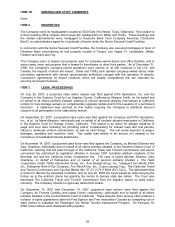Thrifty Car Rental 2008 Annual Report Download - page 16
Download and view the complete annual report
Please find page 16 of the 2008 Thrifty Car Rental annual report below. You can navigate through the pages in the report by either clicking on the pages listed below, or by using the keyword search tool below to find specific information within the annual report.
U.S. Fleet Data
2008 2007 2006
DTG
Average number of vehicles leased to
franchisees 2,754 4,309 8,836
Average number of vehicles in
combined fleets of franchisees 18,171 22,696 29,095
Average number of vehicles in combined
fleets of company-owned stores 115,129 117,488 113,762
Total 133,300 140,184 142,857
Year Ended December 31,
Competition
There is intense competition in the vehicle rental industry on the basis of price, service levels, vehicle
quality, vehicle availability and the convenience and condition of rental locations. Dollar and Thrifty and
their franchisees operate mainly in the U.S. airport market, relying on leisure, tour and small business
customers. Dollar and Thrifty and their franchisees’ principal competitors are Alamo, Avis, Budget,
Enterprise, Hertz and National.
The Canadian vehicle rental markets are also intensely competitive. Most of the Canadian market is
operated either directly or through franchisees of the major U.S. vehicle rental companies, including
Alamo, Avis, Budget, Enterprise, Hertz and National, as well as Dollar and Thrifty.
Insurance
The Company is subject to third-party bodily injury liability and property damage claims resulting from
accidents involving its rental vehicles. In March 2006 and 2007, the Company retained risk of loss up to
$4.0 million per occurrence for public liability and property damage claims, plus a self-insured corridor of
$1.0 million per occurrence for losses in excess of $4.0 million with an aggregate limit of $7.0 million for
losses within this corridor. In February 2008 and continuing through January 2009, the Company
increased its retained risk of loss up to $5.0 million per occurrence for public liability and property damage
claims, including third-party bodily injury and property damage. The Company maintains insurance
coverages at certain amounts in excess of its retained risk. The Company retains the risk of loss on
supplemental liability insurance sold to vehicle rental customers.
In February 2009, the Company increased its retained risk of loss up to $7.5 million per occurrence for
public liability and property damage claims, including third party bodily injury and property damage.
Starting in 2006 the Company retained risk of loss up to $5.0 million for general and garage liability. The
Company retains the risk of loss for any catastrophic and comprehensive damage to its vehicles. In
addition, the Company carries workers' compensation coverage with retentions in various amounts up to
$500,000. The Company also carries excess liability and directors' and officers' liability insurance
coverage.
Provisions for bodily injury liability and property damage liability on self-insured claims and for
supplemental liability insurance claims (collectively referred to as “Vehicle Insurance Reserves”) are
made by charges to expense based upon periodic actuarial evaluations of estimated ultimate liabilities on
reported and unreported claims. As of December 31, 2008, the Company had Vehicle Insurance
Reserves of $110.3 million. The Company’s obligations to pay insurance related losses and indemnify
the insurance carriers for fronted policies are collateralized by surety bonds and letters of credit. As of
December 31, 2008, these letters of credit and surety bonds totaled approximately $56.0 million and $7.0
million, respectively.
14


